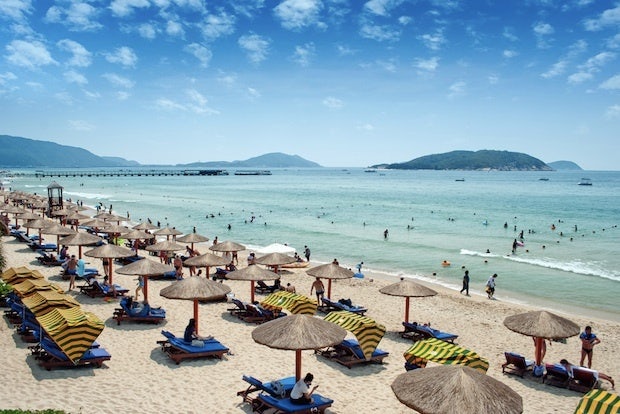
Sanya's tropical beaches aren't the only reason Chinese tourists are flocking to Hainan. (Shutterstock)
An unlikely "battleground" for luxury brands has emerged in the hallways of Hainan’s airports as its duty-free shops report massive increased spending by consumers, according to recent Chinese media reports. Hainan, a popular destination for its beaches and resorts, saw its duty-free sales climb both last year and during this year's Spring Festival travel season.
A recent article on iFeng quotes National People's Congress delegate and Hainan province governor Jiang Dingzhi's statements on duty-free sales made during this year's the two sessions:
All the numbers strongly indicate that in 2013, Hainan's tourism industry not only exceeded its main growth rate and sped up GDP growth, but the structure of travel also showed active changes. Among these, duty-free merchandise sales were at 3.4 billion RMB [US$552 million] in 2013, an increase of 38.3 percent. "This year, duty-free sales exploded during the one-week holiday period of the Chinese New Year. According to statistics, there was a 30 percent increase in traffic at the Haikou and Sanya airports' duty-free shops, to a total of 56,000 people--merchandise sales increased 33 percent to 224 million RMB [US$36.2 million]."
Tax-free shopping is popular with many Chinese consumers, because with high import duties, value-added tax, and special consumption, price disparities between products in mainland China and overseas can be as much as a 30 percent difference, according to the article.
In April 2011, the Ministry of Finance launched an offshore tax-free policy for the Hainan islands, with its ports, airports, and shops in Haikou and Sanya city as part of the pilot program. The following year, the original roughly $800 limit that can be spent at these shops was raised to about $1,300, and tax exemptions extended to include beauty and healthcare products. The article says that according to industry sources, the offshore tax-free policy is the country’s first step in equalizing the price differences between luxury goods bought overseas and those sold locally. The source also said that this policy is a leap forward for China competitiveness in the luxury goods scene.
Making top travel locales a tax-free shopping haven makes economic sense—travelers spend a significant amount of time at airports with little to do while waiting for flights. Often, shopping is a key opportunity for them to kill time. With Chinese consumers being touted as the highest spenders on luxury goods, brands that have capitalized on browsing travelers have seen fruitful returns.
The iFeng article says that on January 20, a few days before Chinese New Year, travelers were shuttling from counter to counter with their shopping baskets filled to the brim in the newly built Haikou Meilan International Airport's cosmetics department. Consumers told reporters that the limit on cosmetics had increased from five to eight items.
“Not only can I buy a year’s worth of cosmetics for myself here, but also bring some back for a colleague or friend,” a shopper told the iFeng reporter.
The Hainan islands have profited much from the tax exemption, with merchandise sales soaring. The success of this tax-free pilot program will likely lead to speculation as to whether the policy may migrate off of China’s southernmost and smallest province into more mainland areas in the future.